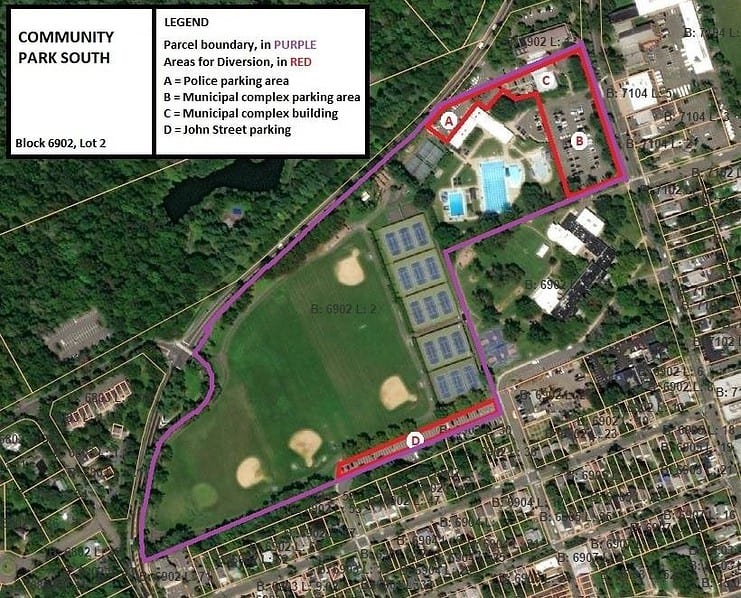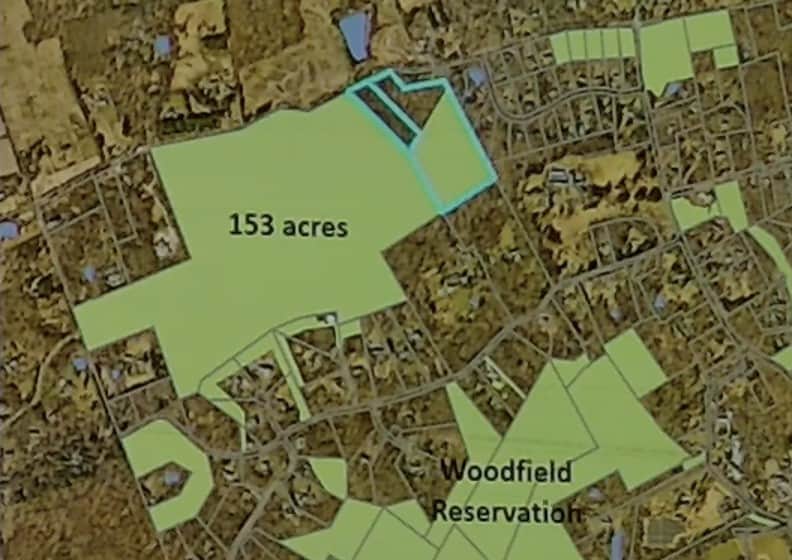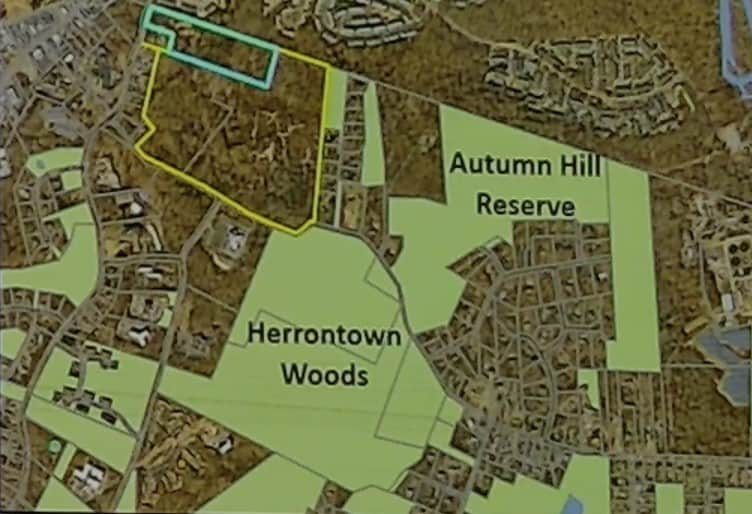Officials want to buy three parcels of land in northern section of Princeton to replace open space diverted for municipal complex

To make up for park and recreation land being diverted from the most densely populated area of Princeton, town officials are proposing to preserve land along the Princeton Ridge in the wooded northern part of the municipality.
Local officials are seeking to purchase two parcels of land along the Princeton Ridge off of Cherry Valley Road and one parcel of land off of Mt. Lucas Road to make up for Princeton Township mistakenly building its municipal complex on land that was preserved through the state’s Green Acres program. The purchases will cost the town at least seven figures, an official said Monday night at a forum for public comment on the proposal.
Princeton Township built most of its new municipal complex in 2002 on just over three acres of land that were supposed to be used for parks and recreation as part of Community Park under the state’s Green Acres program. Prior to 2002, the township’s offices were located across the street in the Valley Road building, which is now owned by the Princeton Public Schools. The township’s diversion of the parkland for its municipal complex and parking lot was discovered more than two decades later in 2023 when the municipality was completing its most recent open space and park inventory.
The state’s remedy for diverting land is to require the municipality to preserve other properties. Under state regulations, the municipality must preserve five acres of land for every acre that was diverted. In other words, the town must buy about 15 acres of land to replace the land it took for the municipal building and parking lots.
Cindy Taylor, the town’s open space manager, said the town’s draft plan and the public comment period are part of a two-year process to remedy the situation.

Taylor said the town intends to buy and preserve two parcels of land along the Princeton Ridge in the north part of Princeton off of Cherry Valley Road near Province Line Road. The properties are contiguous with 153 acres of land the municipality bought in 2021. The area is part of an initiative called Princeton’s “Emerald Necklace” that aims to connect open spaces in the municipality and beyond. The parcels include mature forests and have been designated as a medium-high priority in the New Jersey Conservation Blueprint.

The town also wants to buy land in the northeastern area of the Princeton Ridge off of Mt. Lucas Road which is part of a 90-acre tract that was targeted for conservation in Princeton’s 2011 open space and recreation plan. The land includes 100-year-old forests and is part of a contiguous ecosystem with Herrontown Woods and the Autumn Hill Reservation. The parcel is designated as a medium-high and medium priority in the New Jersey Conservation Blueprint.

During the public comment period for the meeting that lasted just over half an hour, some residents questioned why all the properties being preserved are located in the north instead of in the more densely populated areas of town closer to the municipal complex, and raised questions about equity and park access.
John Street resident Annie Dunham asked that the portion of Community Park that is used for ad hoc municipal storage be rededicated to recreation space. She said vehicles and other items are located near the platform tennis courts and the picnic pavilion, including a trash vehicle, plow parts, and a shed. Municipal Administrator Bernard Hvozdovic Jr. said the equipment probably serves the recreation on the site.
Dunham stressed that it is important to find alternate open space in the neighborhood since all the preserved space is being diverted outside of the park and in the northern region of the municipality.
“This census block will meet the criteria for an overburdened community as part of the environmental justice initiative for equitable access to high-quality recreation spaces,” Dunham said, adding that the officials should try to find whatever recreational spaces they can for the Witherspoon Jackson neighborhood since the land was taken from the park in that neighborhood. She suggested moving the municipal public works yard that is in the neighborhood so that the property could also be used for open space.
Hibben Road resident Jo Butler also said town officials should preserve open space closer to the center of town. She suggested that the town preserve the 2.1-acre field at the corner of Hibben Road and Mercer Street.
“I feel like I should have gone to my tennis drill tonight because I feel like the decisions have already been made and this is a bit of a waste of time,” Butler said of the meeting. She said the Hibben property was on the former Princeotn Borough’s list of potential open space purchases and was identified in the open space and recreation element in 2011. Officials recommended at the time that deed restrictions be obtained for the property, which is owned by Princeton Theological Seminary and is now part of the seminary’s properties that are part of the area town officials designated as an area in need of redevelopment.
“We’ve been very successful at purchasing open space outside of the former borough and on the ridge before. I think some of this (ridge) land is not likely to be developed any time soon. And I think that this (Hibben) property could be developed rather soon. So to me, it’s a more urgent opportunity,” Butler said. “I think as we continue to add population and housing in Princeton, it would also be nice to have more recreational space closer in.”
Butler said she isn’t sure whether the 2.2-acre field is big enough for an athletic field, but that it could be used for a soccer field or pick-up games for residents. The town does not have enough sports fields, she said.
Another piece of property on Stockton Street has some undeveloped land in the rear that could become part of Marquand Park, Butler said.
Hvozdovic asked Butler whether the seminary would be a willing seller. He said the property owners the town is proposing to buy land from are willing sellers.
“Were they for sale or did you go talk to them?” Butler asked about the Princeton Ridge properties the town wants to buy.
“Well, kind of a little of both,” Hvozdovic said. “I would just like to note, just because we’re buying these for the diversion doesn’t foreclose other open space purchases in the future.”
Butler asked what Hvozdovic meant by “buying” and asked if the town already has committed to buying the Princeton Ridge properties. He said the town is at the appraisal stage for purchasing the properties. “Whether it was a diversion or not, we probably would have looked at those properties just because of their ecological value anyway,” Hvozdovic said.
Travis Webber of Birch Avenue expressed concerns about the development of the area around Community Park South and said a petition was circulated in the Witherspoon Jackson neighborhood in recent weeks regarding development concerns.
Princeton resident Sophie Glovier of the Watershed Institute said her organization has been working as part of a consortium to support the idea of the green emerald necklace in Princeton. She said the purchase of the Princeton Ridge properties is a “far-sighted investment for the community.” The properties have high conservation value, she said, and feature exceptional wetlands.
Princeton resident Christopher Barr, who lives on Ridgeview Road and is the executive director of the Ridgeview Conservancy, said the parcels selected by the town are extremely important because of the mature forests, climate resistance efforts, carbon capture, stormwater runoff mitigation, wildlife, and biodiversity. “They are an important piece of the green legacy that I think we all want to leave for the next generations,” Barr said. ‘The parcels that have been identified for conservation are important linkage properties.”
Barr said the Mt. Lucas property in the northeast corner of Princeton is one of three properties owned by the Lanwin Corporation. The company is proposing to build 29 homes on those properties.
Patrick DeAlmeida of Race Street asked how the diversion happened without permission. “It seems like a big mistake,” DeAlmeida said. “And how much is that going to cost us? Because if we had asked permission 20 years ago, I assume the land would have been a lot cheaper to purchase than it is today.”
Hvozdovic said he didn’t have an answer.
“No one sitting at this table was here, so I can’t answer how it happened,” Hvozdovic said. “It should not have happened, but it happened, so we find ourselves here. How much it will cost us we don’t know yet because we’re not at the point of actually purchasing the property.”
DeAlmeida asked whether the amount would be in the millions of dollars.
“The properties together that we will be replacing will certainly be seven figures when you add it all up,” Hvozdovic said. “But we do end up with more property at the end of the day. So we are buying open space. But yes, it’s going to cost more than it would have certainly 20 years ago.”
DeAlmeida asked whether there was information regarding the law firm that was involved during the planning process to create the new municipal complex and parking lot. The lawyer for the town at the meeting, Priscilla Saint-Laurent of Mason, Griffin & Pierson, said there is no further information about what happened other than what has been presented. “So what we are doing is moving forward and everyone here is looking to correct whatever issue was presented at that time, and we will do,” Saint-Laurent said. He did say the firm back then was the same firm representing the town now, which is Mason, Griffin & Pierson. DeAlmeida suggested the municipality follow up and determine what happened.
Patton Avenue resident Scott Sillars, who served on The Watershed Institute board for nine years and is married to Margaret Griffin, daughter of Mason, Griffin & Pierson co-founder Gordon Griffin, praised the town for how it is handling things.
“I’d like to commend the administration and the open space community for maintaining such an aggressive and thorough inventory of open space priorities and what we’d like to purchase in the future, do that when an unfortunate situation like this arises it doesn’t complicate our ability to move forward with open space purchases that we had in mind in the first place,” Sillars said. “Thereby, the delay in our ability to access open space funding and Green Acres funding in the future is minimized because we already have a good idea of what our plan on acquisitions, we’re going forward.”
Sillars also said in his opinion, the fact that the town has to use the funds to ameliorate the problem is separate from plans to acquire open space from third parties. “Had this situation not arisen, we would and we wanted to acquire the same amount of open space from other pockets,” Sillars said. “In any event, we would have still had to go out and raise the same amount of money. Therefore this is not really an additional amount of funding that we’re going to have to go out and find.”
Residents who couldn’t make it to the meeting Monday night can send feedback to engineering@princetonj.gov or mail comments to Cindy Taylor, Open Space Manager, Municipality of Princeton, 400 Witherspoon Street, Princeton, NJ 08540. Send a copy of comments to the New Jersey Department of Environmental Protection by emailing Maude Snyder at maude.snyder@dep.nj.gov or sending comments by mail to Maude Snyder, NJDEP, 401 East State Street, 7th Floor, Box 420, Trenton, NJ 08625-0420.
Public comments will be accepted until April 17.


When will they fix Clay street? And the senior housing off Harrison street. Hopefully it is part of the plan.
Often I walk or drive through that street to deliver groceries and the buildings really need renovating. Also there seems to be a parking problem on Clay st. Just because it is affordable housing doesn’t mean it has to look that way. Our neighbors who live there deserve to live some place they are proud of .
I find it truly bizarre that you mention me and my LONG-dead father and the law firm that he founded and retired from LONG before he died, in relation to this open space issue. Wow! I did not attend the meeting nor do I have particular feelings on the subject. I assure you my husband’s suggestions about resolving the problem have nothing to do with me or my father! You seem to be reaching into some strange conspiratorial territory. But I guess that’s nothing new and in this case it’s not too serious, just a little laughable.
It would be nice if the lot on Franklin St. could be turned into open space instead of being jammed full of more apartments. The current affordable housing units could be rebuilt in a multi level building with a smaller footprint.
I served as Twp. Adm from 1983 to 2012. When the new Twp Hall was constructed it was built on the same lands as the former Twp Hall. These lands were owned by the Twp for many, many years, long before the Green Acres program existed.
It’s conjecture on my part but I suspect what happened is the municipal complex lands were mistakenly included in the Town’s open space inventory, resulting in Green Acres citing the Twp for a “diversion”, which of course it was not.
That’s the only rational explanation unless there was some diversion that occurred after I left in 2012 that I know nothing about.
I would encourage staff & Town Council to take a very hard look at Green Acres claim of diversion.
Dear Jim:
I think your “conjecture” is true, and that all this brouhaha is much ado about nothing that will result in our taxpayer funds being used to enrich the current owners of the property in question. The Green Acres claim of diversion is, in all likelihood, invalid. Therefore, the town should STOP this remediation process immediately, and not waste any further resources until a legal determination can be made as to your very astute (and very likely correct) observation. Thank you for your vigilance and for sharing your experience on this matter from your nearly thirty years as town administrator.
Sincerely,
Devin Hosea
Princeton Resident
Another reporter wrote that the town would need to preserve 5 acres of space for each acre they plowed over and built the administrative offices. That would be 15 acres and not three. Why is land only preserved in one area of Princeton? What about the rest of Princeton residents who would like equitable access to open space within walking distance?
That is in this story as well. Five acres for every acre diverted.